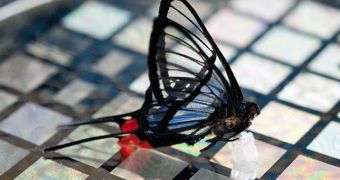A team of experts may have just developed the foundation for producing artificial skin. They constructed a series of electronic sensors that are both ultra-sensitive and highly flexible.
According to the investigators, it would appear that the innovation is capable of sensing touches as light as butterfly, which makes it comparable in sensitivity with human skin.
Scientists believe that, when manufactured in large sheets, such sensors could be used as artificial skin, attached to the surface of prosthetic limbs, robots, touch-screens and medical devices as well.
The group, which is based at the Stanford University, is the first to manage to achieve such extreme sensitivity to touch. Others have been trying in vain to obtain the same effect.
The human skin, through its specialized receptors, does it naturally, having developed the ability over millions of years of evolution. But obtaining this type of sensitivity electronically is very difficult.
The electronic sensor is made out of a rubber layer, that sit between two parallel electrodes. The middle layer is precisely molded, and is made out of highly elastic rubber.
“It detects pressures well below the pressure exerted by a 20 milligram bluebottle fly carcass we experimented with, and does so with unprecedented speed,” explains Stanford researcher Zhenan Bao.
She is the leader of the research team, and also an associate professor of chemical engineering at the university.
“We found that with a very thin continuous film, when you press on it, the material does not have room to expand,” adds scientist Stefan Mannsfeld.
He is a former postdoctoral researcher in chemical engineering at Stanford, as well as a coauthor of a new paper detailing the findings.
The work was published in the September 12 online issue of the esteemed scientific journal Nature Materials.
“So the molecules in the continuous rubber film are forced closer together and become entangled. When pressure is released, they cannot go back to the original arrangement, so the sensor doesn't work as well,” he adds of the problems plaguing similar sensors.
“The microstructuring we developed makes the rubber behave more like an ideal spring,” Mannsfeld goes on to explain.
“If we can make this in higher resolution, then potentially we should be able to have the image on a coin read by the sensor,” Bao concludes.
Description: Researchers can measure the pressure from a butterfly registered by the sensors.
Credit: Jack Hubbard

 14 DAY TRIAL //
14 DAY TRIAL //